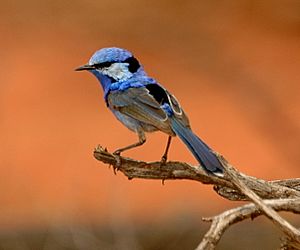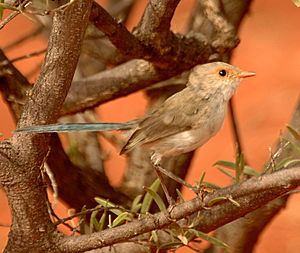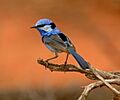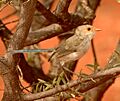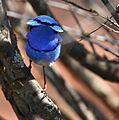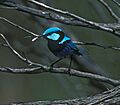Splendid fairywren facts for kids
The splendid fairywren (Malurus splendens) is a small, colorful bird that belongs to the Australasian wren family. You might also hear it called the splendid wren or, especially in Western Australia, the blue wren. These birds live across many parts of Australia, from central-western New South Wales and southwestern Queensland all the way to the coast of Western Australia. They prefer dry and semi-dry areas.
Splendid fairywrens are known for their striking differences between males and females. During the breeding season, the male bird is mostly bright blue and black with a long tail. However, females, young birds, and males not in breeding season are mostly grey-brown. This difference once made people think that males had many partners, because all the dull-colored birds were assumed to be females.
Like other fairywrens, these birds have interesting social lives. Even though they form pairs, both partners might mate with other birds. Sometimes, they even help raise the chicks from these other pairings! Male wrens also have a special way to attract females: they pick up pink or purple flower petals and show them off as part of their courtship dance.
Splendid fairywrens live in various places, from forests to dry scrublands, as long as there's enough plant cover for shelter. Unlike the superb fairywren, they haven't adapted well to areas where humans live and have disappeared from some cities. Their main food is insects, but they also eat some seeds.
Quick facts for kids Splendid fairywren |
|
|---|---|
 |
|
| A male splendid fairywren (subsp. splendens) in Western Australia | |
| Conservation status | |
| Scientific classification | |
| Genus: |
Malurus
|
| Species: |
splendens
|
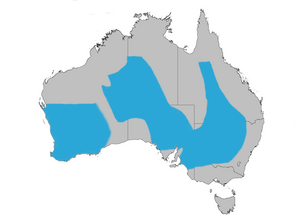 |
|
| Splendid fairywren range | |
| Synonyms | |
|
|
Contents
About the Splendid Fairywren Name
The splendid fairywren is one of eleven types of birds in the Malurus group, which are commonly called fairywrens. These birds are found in Australia and New Guinea. The splendid fairywren is most closely related to the superb fairywren. Both of these are known as "blue wrens."
The first splendid fairywrens were found at King George Sound in Western Australia. French naturalists Jean René Constant Quoy and Joseph Paul Gaimard officially described the bird in 1830. They named it Saxicola splendens. Later, in 1833, John Gould gave it a different scientific name, Malurus pectoralis, and called it the "banded superb-warbler." However, the name given by Quoy and Gaimard was used first, so it became the official one. The word splendens comes from Latin and means "shining."
It's important to know that fairywrens are not related to the "true wrens" found in other parts of the world. For a long time, scientists weren't sure where to place fairywrens in the bird family tree. Eventually, in 1975, they were placed in their own family called Maluridae. More recent studies of their DNA show that the Maluridae family is related to honeyeaters and pardalotes.
The splendid fairywren is sometimes also called the splendid blue wren.
Different Types of Splendid Fairywrens
At first, scientists thought that three of the splendid fairywren's subspecies were actually separate species. This was because they were found in places far apart from each other. But as people explored more of Australia, they found areas where these different types met and even bred together. Because of this, in 1975, they were all reclassified as subspecies of the splendid fairywren.
Today, there are four recognized subspecies:
- Banded fairywren (M. s. splendens): This is the original type. It lives in central and southern Western Australia. It's also known as the banded wren or banded blue wren.
- Turquoise fairywren (M. s. callainus): This type was first described by John Gould in 1867. It has lighter blue or turquoise feathers on its upper body and a black rump. It lives in the mulga and mallee areas of South Australia and the southern Northern Territory. It's also called the turquoise wren.
- Black-backed fairywren (M. s. melanotus): Described in 1841, this subspecies has a black back and a whitish lower belly. It lives in the mallee areas of South Australia, western Victoria, western New South Wales, and southwestern Queensland. It's also known as the black-backed wren.
- M. s. emmottorum: This subspecies was named after Angus Emmott, a farmer and biologist. It is found in southwestern Queensland.
What They Look Like
The splendid fairywren is a small bird, about 14 centimeters (5.5 inches) long, with a long tail. Males and females look very different, especially during the breeding season.
The breeding male is easy to spot with his bright blue forehead, ear patches, and a purple throat. His back, wings, chest, and tail are a deeper, rich blue. He also has a black beak, a black band across his eyes, and a black band on his chest. This bright blue breeding plumage is often called "nuptial plumage."
When not breeding, the male is brown with some blue on his wings and a bluish tail. The female looks similar to the non-breeding male, but she has a chestnut-colored beak and a chestnut patch around her eye.
Young males will get their breeding colors in their first breeding season after hatching. However, their colors might not be perfect at first and could take another year or two to fully develop. Both male and female birds shed their feathers (molt) in autumn after breeding. Males then get their duller non-breeding feathers. They will molt again in winter or spring to get their bright breeding colors back. Some older males stay blue all year round.
The blue feathers of breeding males, especially on their ear patches, are very shiny and change color in the light. This is because of the special shape of their tiny feather parts. This blue color also reflects ultraviolet light strongly. This means other fairywrens, who can see ultraviolet light, might see the males as even brighter and more colorful.
Their call is described as a gushing, loud trill, which sounds harsher than other fairywrens' calls. Each bird's call is a bit different. A soft, single "trrt" sound is used to keep in touch with other birds in their group while they are looking for food. When there's danger, they make a "tsit" alarm call. If a predator or another bird like a cuckoo comes near, they might make a churring sound and show a threat posture. Females make a "purr" sound when they are sitting on their eggs.
Where They Live
The splendid fairywren lives in dry and semi-dry parts of Australia. Their homes are usually dry and bushy areas, like mulga and mallee forests in drier regions, and wooded areas in the southwest. The western and eastern types of splendid fairywrens tend to stay in one place. However, the turquoise fairywren is thought to move around more.
Unlike the superb fairywren, the splendid fairywren has not adapted well to living near humans. They have disappeared from some city areas. They also don't like pine or eucalyptus tree farms because these places don't have enough undergrowth for them to hide in.
Daily Life and Habits
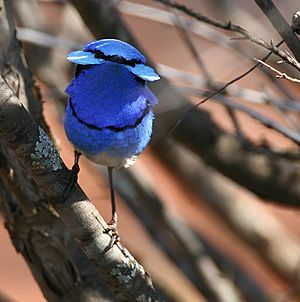
Like all fairywrens, the splendid fairywren is always busy looking for food. They often search on open ground near places to hide, but also among the lower leaves of plants. They move by hopping and bouncing, using their long tails to help them balance. Their tails are usually held upright and are rarely still. Their short, rounded wings are good for quick take-offs and short flights, but not for flying long distances. However, splendid fairywrens are stronger fliers than most other fairywrens.
During spring and summer, the birds are active in bursts throughout the day, singing as they look for food. Since insects are plentiful and easy to catch, the birds can rest between their feeding times. The group often rests together in a sheltered spot during the hottest part of the day. In winter, food is harder to find, so they have to spend most of the day looking for it.
Groups of two to eight splendid fairywrens stay in and protect their territory all year. Their territories are usually about 4.4 hectares (10.9 acres) in woodland-heath areas. The size of their territory can change depending on how dense the plants are and how many males are in the group. A group usually has a main pair that mates for life, plus one or more male or female helper birds. These helpers were born in the territory, but they might not be the children of the main pair.
Splendid fairywrens are known for mating with other birds outside their main pair. More than a third of their chicks are fathered by males from other groups. Helper birds assist in defending the territory and feeding the young. Birds in a group sleep close together in thick bushes and also help each other clean their feathers.
Many animals hunt splendid fairywrens, including magpies, butcherbirds, kookaburras, currawongs, crows, and ravens. Introduced mammals like red foxes, cats, and black rats are also predators. To protect their nests and young, splendid fairywrens might do a "rodent-run" display. They lower their head, neck, and tail, spread their wings, fluff their feathers, and run quickly while making a continuous alarm call. This display tries to distract predators away from their nests.
Courtship and Mating
Male splendid fairywrens have several special ways to attract a mate. One is called the "sea horse flight." In this display, the male flies in an exaggerated wavy pattern, like a seahorse. He stretches his neck, raises his head feathers, and tilts his body from horizontal to vertical. He beats his wings quickly to slowly go down and then spring back up after landing. The "face fan" display is when the male flares out his blue ear tufts by raising his feathers. This can also be a sign of aggression.
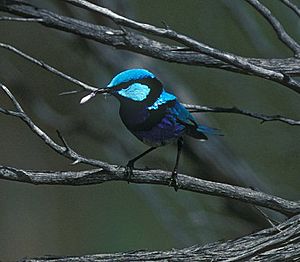
Another interesting habit of male fairywrens during the breeding season is to pick flower petals. For splendid fairywrens, these are usually pink and purple petals, which stand out against their blue feathers. They show these petals to female fairywrens. Petals are often part of a courtship display and are given to a female in the male's own territory or even in another territory. Even outside the breeding season, males might show petals to females in other territories, perhaps to show off.
Even though fairywrens form pairs for life, they often mate with other birds. This means that some of the young chicks will have different fathers from outside the group. The young are often raised not just by the main pair, but also by other males who mated with the female. So, carrying petals might help strengthen the bond between the main pair. It could also be a way for other males to get a chance to mate with the female. However, studies haven't strongly shown a direct link between carrying petals and mating right after.
Scientists have also found that male splendid fairywrens sing special songs (called Type II song) when they hear calls from predators. These songs "hitchhike" on the predator's sounds. Female splendid fairywrens become more alert because of the predator calls and respond more strongly to these Type II songs when they hear them after a predator call.
Reproduction and Life Cycle
Splendid fairywrens breed from late August to January. However, if there's a lot of rain in August, breeding might start later. The female builds the nest, which is a round or dome-shaped structure made of loosely woven grasses and spider webs. It has an entrance on one side and is usually hidden close to the ground in thick, often thorny, plants. They might lay one or two sets of eggs during the breeding season.
A female lays two to four dull white eggs with reddish-brown spots. Each egg is about 12 by 16 millimeters (0.5 by 0.6 inches). The female sits on the eggs for about two weeks (14 or 15 days). After the eggs hatch, all the birds in the group help feed the nestlings and remove their waste. The young birds leave the nest after 10 to 13 days. Young birds stay with their family group as helpers for a year or more. Then, they might move to another group nearby or take a leading role in their original group. As helpers, they feed and care for future broods of chicks.
Sometimes, splendid fairywrens become hosts to other birds that lay their eggs in their nests. The Horsfield's bronze cuckoo often does this, and the shining bronze cuckoo has also been recorded.
What They Eat
The splendid fairywren mainly eats insects. Their diet includes many small creatures like ants, grasshoppers, crickets, spiders, and bugs. They also eat small amounts of seeds, flowers, and fruit. They usually look for food on the ground or in bushes less than two meters (6.5 feet) tall. This way of finding food is called "hop-searching." Unusually for fairywrens, they sometimes also look for food in the tops of flowering gum trees.
Birds tend to stay close to cover and look for food in groups. This is because searching for food makes them vulnerable to many predators. Food can be hard to find in winter, so ants become a very important "last resort" food source, making up a much larger part of their diet. Adult fairywrens feed their young a different diet, giving them larger items like caterpillars and grasshoppers.
Splendid Fairywrens in Culture
The splendid fairywren was supposed to be on an Australia Post stamp released in 1999. However, a superb fairywren was mistakenly shown instead!
Images for kids
-
Male, ssp. emmettorum
Cunnamulla, SW Queensland -
Subspecies melanotus with face fan display, Lake Cargelligo
-
Turquoise fairywren (subsp. callainus) with purplish petal – Gawler Ranges, South Australia
See also
 In Spanish: Maluro espléndido para niños
In Spanish: Maluro espléndido para niños



